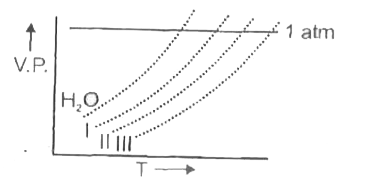Which one of the following aqueous solutions will exhibit highest elevation in boiling point?
0.015 M urea
0.01 M KNO3
0.10MNa2SO4
0.015 m glucose
The correct Answer is:c
To determine which aqueous solution exhibits the highest elevation in boiling point, we can follow these steps:
Step 1: Understand the Concept of Boiling Point Elevation
The elevation in boiling point (ΔTb) is a colligative property that depends on the number of solute particles in a solution. The formula for boiling point elevation is given by:
ΔTb=Kb×m×i
where:
- ΔTb = elevation in boiling point
- Kb = ebullioscopic constant (specific to the solvent)
- m = molality of the solution
- i = Van't Hoff factor (number of particles the solute dissociates into)
Step 2: Analyze Each Solution
We need to evaluate the Van't Hoff factor (i) for each solute given in the options:
1. Urea: Urea is a non-electrolyte and does not dissociate in solution. Therefore, i=1.
2. KNO3 (Potassium Nitrate): KNO3 dissociates into K+ and NO−3. Thus, i=2.
3. Na2SO4 (Sodium Sulfate): Na2SO4 dissociates into 2Na+ and SO2−4. Therefore, i=3.
4. Glucose: Similar to urea, glucose is a non-electrolyte and does not dissociate. Hence, i=1.
Step 3: Compare the Van't Hoff Factors
Now we can summarize the Van't Hoff factors for each solution:
- Urea: i=1
- KNO3: i=2
- Na2SO4: i=3
- Glucose: i=1
Step 4: Determine the Highest Elevation in Boiling Point
Since the elevation in boiling point is directly proportional to the Van't Hoff factor (i), the solution with the highest i will have the highest elevation in boiling point.
From our analysis:
- The highest i value is for Na2SO4, which is 3.
Conclusion
Thus, the aqueous solution that will exhibit the highest elevation in boiling point is:
0.1 molar Na2SO4 (Option C).
---
The elevation in boiling point (ΔTb) is a colligative property that depends on the number of solute particles in a solution. The formula for boiling point elevation is given by:
ΔTb=Kb×m×i
where:
- ΔTb = elevation in boiling point
- Kb = ebullioscopic constant (specific to the solvent)
- m = molality of the solution
- i = Van't Hoff factor (number of particles the solute dissociates into)
We need to evaluate the Van't Hoff factor (i) for each solute given in the options:
2. KNO3 (Potassium Nitrate): KNO3 dissociates into K+ and NO−3. Thus, i=2.
Now we can summarize the Van't Hoff factors for each solution:
- Urea: i=1
- KNO3: i=2
- Na2SO4: i=3
- Glucose: i=1
Since the elevation in boiling point is directly proportional to the Van't Hoff factor (i), the solution with the highest i will have the highest elevation in boiling point.
- The highest i value is for Na2SO4, which is 3.
Thus, the aqueous solution that will exhibit the highest elevation in boiling point is:
0.1 molar Na2SO4 (Option C).
Topper's Solved these Questions
- DILUTE SOLUTIONBOOK - NARENDRA AWASTHI ENGLISHCHAPTER - DILUTE SOLUTIONEXERCISE - leval-02
26 Videos
- DILUTE SOLUTIONBOOK - NARENDRA AWASTHI ENGLISHCHAPTER - DILUTE SOLUTIONEXERCISE - leval-03
23 Videos
- CHEMICAL EQUILIBRIUMBOOK - NARENDRA AWASTHI ENGLISHCHAPTER - CHEMICAL EQUILIBRIUMEXERCISE - Match the column
1 Videos
- ELECTROCHEMISTRYBOOK - NARENDRA AWASTHI ENGLISHCHAPTER - ELECTROCHEMISTRYEXERCISE - Subjective problems
14 Videos
Similar Questions
Knowledge Check
Which of the following aqueous solution should have the highest boiling point ?
A1.0 M NaOHB1.0 M Na2SO4C1.0 M NH4NO3D1.0 M KNO3

Which is having highest elevation in boiling point?
View SolutionWhich solution will show maximum elevation in boiling point?
View SolutionWhich of the following aqueous solution should have the highest boiling point ?
View SolutionWhich of the following aqueous solution has the highest boiling point
View SolutionWhich of the following aqueous solution has the highest feezing point ?
View SolutionWhich one of the following aqueous solution has the highest freezing point at 1 atm:
View SolutionWhich one of the following solution will highest conductivity ?
View Solution
